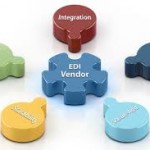
EDI, which stands for electronic data interchange is the exchange of information or documents between different incompatible systems. The actual exchange of information can be electronic on one side and document based on the other. The cost savings can be significant in large part due to operational efficiencies, reduced errors and speed.
 EDI services replace traditional supply chain orders. Older systems involved sending order requests or purchase orders. Some of these were paper based which slowed down the process even more. EDI systems can receive orders through the system from clients and transmit those orders direct to vendors. This process requires no human intervention. Even on the end of the supplier, once the order is received, production or shipping can be immediate.
EDI services replace traditional supply chain orders. Older systems involved sending order requests or purchase orders. Some of these were paper based which slowed down the process even more. EDI systems can receive orders through the system from clients and transmit those orders direct to vendors. This process requires no human intervention. Even on the end of the supplier, once the order is received, production or shipping can be immediate.
The most typical use of EDI is for documents such as invoices, purchase and or shipping orders. Some even use it for customs papers and inventory.
In order for EDI to work, each side of the exchange must set standard formats. This standardization of the formats allows for the EDI system to translate your data and its format, to the format of the other system. To facilitate this there are several standards like ANSI that provide guidance for organizations that want to implement EDI.
There are also third parties that will handle your EDI implementation for you. Connect your system to theirs and they will interface with your suppliers, vendors and clients.